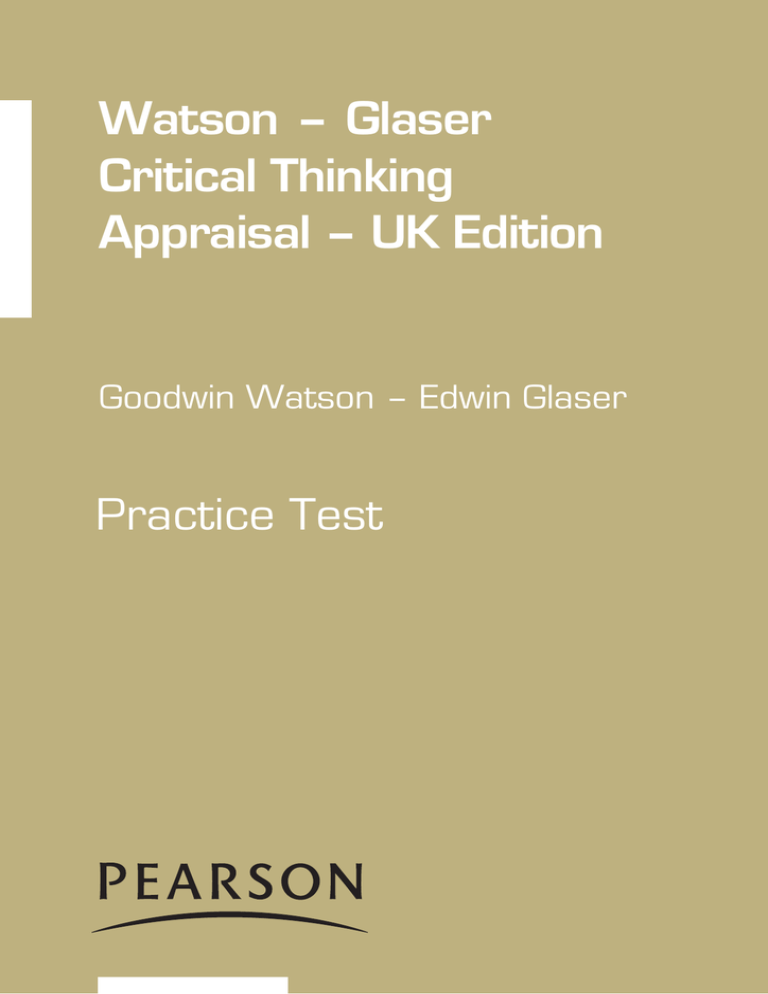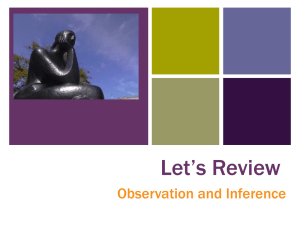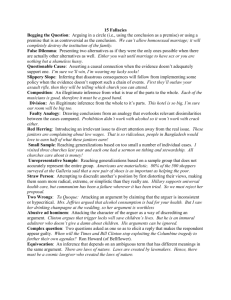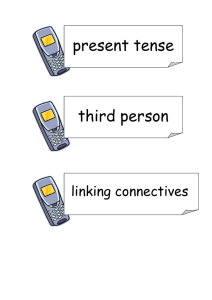
Watson – Glaser
Critical Thinking
Appraisal – UK Edition
Goodwin Watson – Edwin Glaser
Practice Test
Published by Pearson Assessment, 80 Strand, London, WC2R 0RL.
Copyright © 2002, 1993, 1990, 1980, 1964 by The Psychological Corporation.
Adapted by permission.
All rights reserved. No part of this publication may be reproduced or transmitted in any form
or by any means, electronic or mechanical, including photocopy, recording or any retrieval
system, without permission in writing from the publisher.
Printed in England.
ISBN: 978 0 749107 66 6
DIRECTIONS
Turn this booklet over and carefully tear off the back cover. Place it next to this
booklet so that the words Practice Test Record Form are facing up. Don’t look at the
reverse of the Record Form as that’s where the answers are.
Read the instructions below and then do the practice test. Once you have done the
test turn the Record Form over to check your answers.
This booklet contains five types of test designed to find out how well you are able
to reason analytically and logically.
Each test has separate directions that should be read carefully.
All answers are to be marked on the separate Record Form. Use a sharp pencil. If
you wish to change an answer, make sure that you erase your old answer completely.
Test 1: Inference
DIRECTIONS
ID if you decide that there are INSUFFICIENT DATA; that you
cannot tell from the facts given whether the inference is likely to be
true or false; if the facts provide no basis for judging one way or
the other.
An inference is a conclusion that a person can draw from certain
observed or supposed facts. For example, if the lights are on in a
house and music can be heard coming from the house, a person
might infer that someone is at home. But this inference may or may
not be correct. It is possible that the people of the house did not
turn the lights and the radio off when they left the house.
PF if, in the light of the facts given, you think the inference is
PROBABLY FALSE; that it is more likely to be false than true.
In this test, each exercise begins with a statement of facts that you are to
regard as true. After each statement of facts you will find several
possible inferences i.e., conclusions that some persons might draw
from the stated facts. Examine each inference separately, and make
a decision as to its degree of truth or falsity.
F if you believe the inference is definitely FALSE; that it is wrong,
either because it misinterprets the facts given, or because it
contradicts the facts or necessary inferences from those facts.
Sometimes, in deciding whether an inference is probably true or
probably false, you will have to use certain commonly accepted
knowledge or information that practically every person has. This
will be illustrated in the example that follows.
For each inference you will find spaces in the answer sheet labelled
T, PT, ID, PF and F. For each inference put a cross on the answer
sheet under the appropriate heading as follows:
Now look at the example below; the correct answers are indicated
in the box at the right.
T if you think the inference is definitely TRUE; that it properly
follows beyond a reasonable doubt from the statement of facts
given.
In the exercises that follow, more than one of the inferences from a
given statement of facts may be true (T), or false (F), or probably
true (PT), or probably false (PF), or have insufficient data (ID) to
warrant any conclusion. Thus you are to judge each inference
independently.
PT if, in the light of the facts given, you think the inference is
PROBABLY TRUE; that it is more likely to be true than false.
EXAMPLE
Statement:
Two hundred school students in their early teens voluntarily attended a recent weekend student
conference in Leeds. At this conference, the topics of race relations and means of achieving
lasting world peace were discussed, since these were problems that the students selected as
being most vital in today’s world.
Proposed Inferences:
1. As a group, the students who attended this conference showed a keener interest in broad social
problems than do most other people in their early teens. (PT, because, as is common knowledge, most
people in their early teens do not show so much serious concern with broad social problems. It cannot be
considered definitely true from the facts given because these facts do not tell how much concern other
young teenagers may have. It is also possible that some of the students volunteered to attend mainly
because they wanted a weekend outing.)
2. The majority of the students had not previously discussed the conference topics in the schools. (PF,
because the students’ growing awareness of these topics probably stemmed at least in part from
discussions with teachers and classmates.)
3. The students came from all parts of the country. (ID, because there is no evidence for this inference.)
4. The students discussed mainly industrial relations problems. (F, because it is given in the statement of
facts that the topics of race relations and means of achieving world peace were the problems chosen for
discussion.)
5. Some teenage students felt it worthwhile to discuss problems of race relations and ways of achieving
world peace. (T, because this inference follows from the given facts; therefore it is true.)
2
TEST 1
1
2
3
4
5
T
PT
ID
PF
F
T
PT
ID
PF
F
T
PT
ID
PF
F
T
PT
ID
PF
F
T
PT
ID
PF
F
EXERCISES
Statement:
Studies have shown that there is relatively much more heart
disease among people living in the north of England than
people living in the south of England. There is little if any
difference, however, in rate of heart disease between
northerners and southerners who have the same level of
income. The average income of southerners in England is
considerably higher than the average income of northerners.
Proposed inferences:
1. The easiest way to eliminate heart disease in England would be to
raise the general standard of living.
2. People in high income brackets are in a better position to avoid
developing heart disease than people in low income brackets.
3. There is a lower rate of heart disease among northerners with
relatively high incomes than among northerners with much lower
incomes.
4. Whether northerners have high incomes or low incomes makes
no difference to the likelihood of their developing heart disease.
3
go to next page ➪
Test 2: Recognition of Assumptions
DIRECTIONS
An assumption is something presupposed or taken for granted. When you say, ‘I’ll be a qualified
solicitor in two months’, you take it for granted that you will be alive in two months, that you will pass
the relevant examinations, and similar things.
Below are a number of statements. Each statement is followed by several proposed assumptions. You
are to decide for each assumption whether a person, in making the given statement, is really making
that assumption i.e., taking it for granted, justifiably or not.
If you think that the given assumption is taken for granted in the statement, mark ‘YES’ under
‘Assumption made’ in the proper place on the answer sheet. If you think the assumption is not
necessarily taken for granted in the statement, mark ‘NO’ in the space under ‘Assumption made’.
Remember to judge each assumption independently. Below is an example. The box at the right shows
how these items should be marked on the answer sheet.
EXAMPLE
Statement:
‘We need to save time in getting there so we’d better go by plane.’
Proposed assumptions:
1. Going by plane will take less time than going by some other means of transportation. (YES, it is assumed in
the statement that the greater speed of a plane over the speeds of other means of transportation will enable
the group to reach its destination in less time.)
2. There is a plane service available to us for at least part of the distance to the destination. (YES, this is
necessarily assumed in the statement as, in order to save time by plane, it must be possible to go by
plane.)
3. Travel by plane is more convenient than travel by train. (NO, this assumption is not made in the statement –
the statement has to do with saving time, and says nothing about convenience or about any other specific
mode of travel.)
4
TEST 2
1
2
3
Assumption made
NO
YES
Assumption made
NO
YES
Assumption made
NO
YES
EXERCISES
Statement:
‘The proper aim of education in a free society is to prepare
the individual to make wise decisions.’
Proposed assumptions:
5. People who have been educated in a free society will not make
unwise decisions.
6. Some education systems in our society do not have the proper
aim.
7. Some kinds of education can help individuals make wise
decisions.
8. In a society that is not free, the individual cannot make any
decisions.
5
go to next page ➪
Test 3: Deduction
DIRECTIONS
In this test, each exercise consists of several statements (premises) followed by several suggested
conclusions. For the purpose of this test, consider the statements in each exercise as true without exception. Read
the first conclusion beneath the statements. If you think it necessarily follows from the statements
given, mark ‘YES’ under ‘Conclusion follows’ in the proper place on the Answer Sheet. If you think it
is not a necessary conclusion from the statements given mark ‘NO’ under ‘Conclusion follows’, even
though you may believe it to be true from your general knowledge. Similarly, read and judge each of
the other conclusions. Try not to let your prejudices influence your judgement – just stick to the given
statements (premises) and judge whether each conclusion necessarily follows.
The word ‘some’ in any of these statements means an indefinite part of quantity of a class of things.
‘Some’ means at least a portion, and perhaps all of the class. Thus, ‘Some holidays are rainy’ means at
least one, possibly more than one, and perhaps even all holidays are rainy.
Study the example carefully before starting the test.
EXAMPLE
Statement:
Some holidays are rainy. All rainy days are boring. Therefore:
Proposed Conclusions:
1. No clear days are boring. (NO, the conclusion does not follow. You cannot tell from the statements
whether or not clear days are boring. Some may be.)
2. Some holidays are boring. (YES, the conclusion necessarily follows from the statements as, according
to them, the rainy holidays must be boring.)
3. Some holidays are not boring. (NO, the conclusion does not follow, even though you may know that
some holidays are very pleasant.)
TEST 3
1
2
3
6
Conclusion follows
NO
YES
Conclusion follows
NO
YES
Conclusion follows
NO
YES
EXERCISES
Statement:
No responsible leader can avoid making difficult decisions.
Some responsible leaders dislike making difficult decisions.
Therefore:
Proposed conclusions:
9. Some difficult decisions are distasteful to some people.
10. Irresponsible leaders avoid things they dislike.
11. Some responsible leaders do things they dislike doing.
7
go to next page ➪
Test 4: Interpretation
DIRECTIONS
Each of the following exercises consists of a short paragraph followed by several suggested conclusions.
For the purpose of this test, assume that everything in the short paragraph is true. The problem is to judge whether
or not each of the proposed conclusions logically follows beyond a reasonable doubt from the information
given in the paragraph. If you think that the proposed conclusion follows beyond a reasonable doubt (even
though it may not follow absolutely and necessarily), mark ‘YES’ under ‘Conclusion Follows’ in the proper
place on the answer sheet. If you think that the conclusion does not follow beyond a reasonable doubt
from the facts given, mark ‘NO’ under ‘Conclusion Follows’.
Remember to judge each conclusion independently.
Look at the example below; the block at the right shows how the answers should be marked on the record form.
EXAMPLE
Statement:
A study of vocabulary growth in children from eight months to six years old shows that the size
of spoken vocabulary increases from 0 words at age eight months to 2,562 words at age six years.
Proposed Conclusions:
1. None of the children in this study had learned to talk by the age of six months. (YES, the conclusion
follows beyond a reasonable doubt since, according to the statement, the size of the spoken vocabulary at
eight months was 0 words.)
2. Vocabulary growth is slowest during the period when children are learning to walk. (NO, the
conclusion does not follow as there is no information given that relates growth of vocabulary to walking.)
Test 4
1
2
8
Conclusion follows
NO
YES
Conclusion follows
NO
YES
EXERCISES
Statement:
In 1970, 60.4% of adults (people 25 years of age and older) had
completed 11 years or less of schooling, while 4.6% had
completed three or more years of university. In 1990, 40.0% of
adults had completed 11 years or less of schooling, while 7.1%
had completed three or more years of university.
Proposed conclusions:
12. In 1970, most adults had not entered the sixth form.
13. If the trend toward more education continues at the rate
indicated by the above figures, then by 2000 more than 25% of
adults will have completed three or more years of university.
14. In 1990, for every adult who had completed three or more years
of university, there were more than five adults who had completed
not more than 11 years of schooling.
9
go to next page ➪
Test 5: Evaluation of Arguments
DIRECTIONS
In making decisions about important questions, it is desirable to be able to distinguish between
arguments that are strong and arguments that are weak, as far as the question at issue is concerned. For
an argument to be strong, it must be both important and directly related to the question.
An argument is weak if it is not directly related to the question (even though it may be of great
general importance), or if it is of minor importance, or if it is related only to trivial aspects of the
question.
Below is a series of questions. Each question is followed by several arguments. For the purpose of this
test, you are to regard each argument as true. The problem then is to decide whether it is a strong or a weak
argument.
Mark ‘STRONG’ on the answer sheet under ‘Argument’ if you think the argument is strong, or
‘WEAK’ if you think the argument is weak. Judge each argument separately on its own merit. Try not
to let your personal attitude toward the question influence your evaluation of the argument, since each argument is to
be regarded as true.
In the example, note that the argument is evaluated as to how well it supports the side of the question
indicated.
When the word ‘should’ is used as the first word in any of the following questions, its meaning is,
‘Would the proposed action promote the general welfare of the people in the United Kingdom?’
EXAMPLE
Statement:
Should all young people in the United Kingdom go on to higher education?
Proposed Arguments:
1. Yes; college provides an opportunity for them to wear college scarves. (WEAK, this would be a silly
reason for spending years in college.)
2. No; a large percentage of young people do not have enough ability or interest to derive any benefit from
college training. (STRONG. If it is true, as the directions require us to assume, it is a weighty argument
against all young people going to college.)
3. No; excessive studying permanently warps an individual’s personality. (WEAK, this argument, although of
great general importance when accepted as true, is not directly related to the question, because attendance at
college does not necessarily require excessive studying.)
TEST 5
Argument
1
2
WEAK
Argument
STRONG
WEAK
Argument
3
10
STRONG
STRONG
WEAK
EXERCISES
Statement:
Should the government provide ‘baby grants’ to help support
each dependent child in a family so that the family standard of
living is not lowered by having children?
Proposed arguments:
15. Yes; many families who cannot now afford it would then provide
better childcare, and this would greatly improve the general health of
the nation.
16. No; such grants would seriously undermine parents’ sense of
personal responsibility for their own families.
17. No; government provision of ‘baby grants’ would involve
additional public expenditure of money.
STOP
this is the end of the practice test
11
Watson–Glaser Critical Thinking Appraisal
Answers to Practice Test
TEST 1: Inference
TEST 2: Recognition of Assumptions
TEST 3:Deduction
Assumption made
Conclusion follows
9 YES
1 ID
5 NO
2 PT
6 NO
10 NO
3 T
7 YES
11 YES
4 F
8 NO
TEST 4: Interpretation
TEST 5: Evaluation of Arguments
Conclusion follows
Argument
12 YES
13 NO
14 YES
15 STRONG
16 STRONG
17 WEAK
Number Correct
.........................
Number Wrong
........................
Practice Test Record Form
Candidate Details
SURNAME ..................................................
DATE OF TEST ............................................
FIRST NAME ..............................................
INSTRUCTIONS TO CANDIDATES
The answers are on the reverse of this sheet. So do not turn over until you have completed the entire test.
TEST 1: Inference
1
2
3
4
T
PT
ID
PF
F
T
PT
ID
PF
F
T
PT
ID
PF
F
T
PT
ID
PF
F
TEST 2: Recognition of Assumptions
TEST 3:Deduction
Assumption made
Conclusion follows
5
6
7
8
YES
NO
YES
NO
YES
NO
YES
NO
TEST 4: Interpretation
TEST 5: Evaluation of Arguments
Conclusion follows
Argument
12
13
14
YES
NO
YES
NO
YES
NO
15
16
17
STRONG
WEAK
STRONG
WEAK
STRONG
WEAK
9
10
11
Published by Pearson Assessment, 80 Strand, London WC2R 0RL.
Copyright © 2002, 1993, 1990, 1980, 1964 by The Psychological Corporation. All rights reserved. No part of this publication may be reproduced or
transmitted in any form or by any means, electronic or mechanical, including photocopy, recording or any information storage
and retrieval system, without permission in writing from the publisher. Printed in England.
YES
NO
YES
NO
YES
NO




